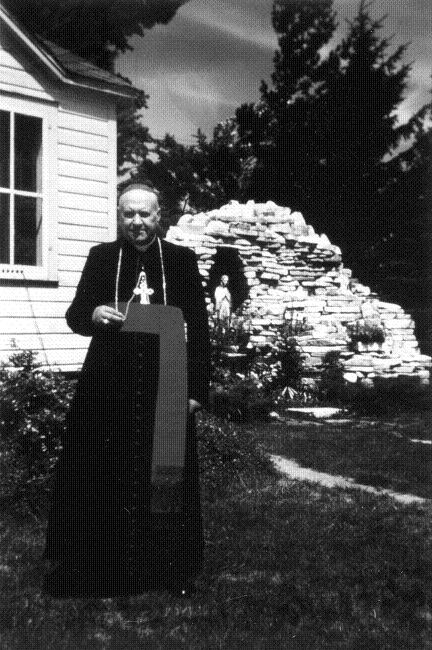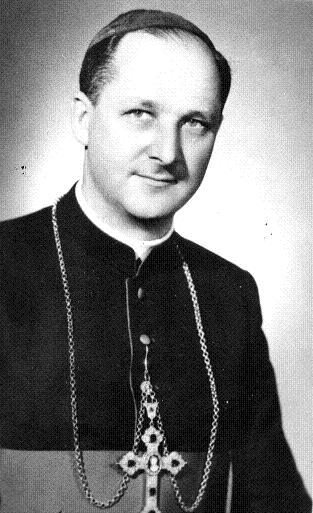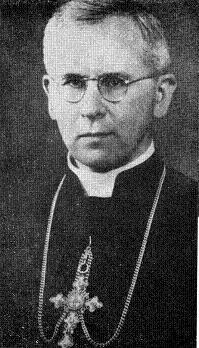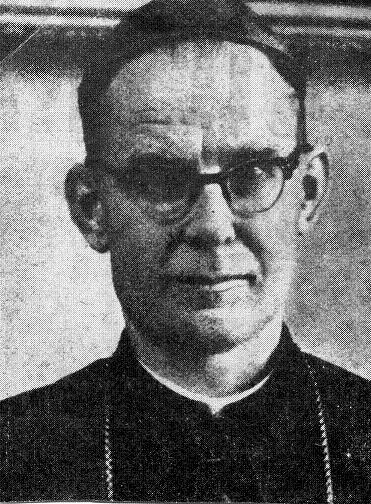Estonia, Latvia and Lithuania became independant after the peace treaty of Brest-Litowski in 1917 respectively 1918. In 1940, the baltic states were occupied by the Soviet Union and got the status of Socialist Soviet Republics within the USSR.
In Estonia, where the catholic minority is organized in an apostolic administration since 1924, Father Eduard Profittlich, S. I., resided since 1932; in 1936 he became Titular Archbishop of Adrianopoli. After the Soviet invasion he was imprisoned and murdered on February 22, 1942. Up to the fall of the USSR no successor could be appointed.
The mainly protestant Latvia was organized in the 1918/1923 re-erected archdiocese of Riga and the diocese of Liepāja, which was established in 1937, with these bishops:
1920 – 1958 Antonijs Springovičs, Bishop (1923 Archbishop) of Riga
1923 – 1970 Jazeps Rancans, Auxiliary Bishop of Riga
1938 – 1965 Antonijs Urbšs, Bishop of Liepāja

Shortly after the communist occupation pastoral work was hindered more and more. Bishop Urbšs was not allowed to fullfill his duties furthermore, and auxiliary bishop Rancans went to exile in the United States. Regarding this circumstances, Archbishop Springovičs consecrated two clandestine bishops on July 25, 1947, in Riga:
Secret Bishop Consecrations 1947:
Kazimirs Dulbinskis, Titular Bishop of Gerara
Peters Strods, Titular Bishop of Stadia.
Both bishops were designated as auxiliary bishops of Riga. Mons. Dulbinskis, who – as well as Mons. Strods – had been appointed on July 19, 1946 – was published in 1957. He was hindered to minister up to 1988; his rehabilitation and beginning of episcopal functions had to wait until Perestrojka policy. The episcopal identity of Mons. Strods was made public in 1955. One year later, besides his function as Riga auxiliary, he became Apostolic Administrator of the vacant-in-fact diocese of Liepāja. 1959, after the death of Archbishop Springovičs, he additionally was appointed Administrator of Riga, just before he himself died in 1960.
The first official bishop’s appointment in Latvia took place on November 10, 1964, when Mons. Julijans Vaivods became Titular Bishop of Macriana maggiore and Apostolic Administrator of Riga and of Liepāja. He was consecrated only eight days after. On February 2, 1983, John Paul II created him as the first cardinal of his country. Additional new bishops during the years of dictatorship were:
1972 – 1986 Auxiliary Bishop Valerians Zondaks, Riga and Liepāja
1982 – 1990 Auxiliary Bishop Janis Cakuls, Riga and Liepāja
1987 – 1991 Auxiliary Bishop Vilhelms Nukšs, Riga and Liepāja
In Lithuania, where the ecclesiastical circumscriptions were newly defined in 1926, resided these bishops in and shortly after 1940:
Kaišiadorys: 1943 – 1962 Bishop Teofilius Matulionis, 1962 Archbishop-Bishop
Kaunas:1926 – 1959 Archbishop Juozapas Skvireckas
Kaunas: 1940 – 1992 Auxiliary Bishop Vincentas Brizgys
Panevezys: 1926 – 1958 Bishop Kazimieras Paltarokas
Telšiai: 1926 – 1943 Bishop Giustino Staugaitis
Telšiai: 1944 – 1946 Bishop Vincentas Borisevicius
Telšiai: 1944 – 1959 Auxiliary Bishop Franas Ramanauskas
Vilkaviškis: 1926 – 1947 Bishop Antonio Karosas
Vilkaviškis: 1940 – 1952 Auxiliary Bishop Vincenzo Padolskis, 1950 Administrator
Vilnius: 1940 – 1954 Auxiliary Bishop Mecislovas Reinys, Titular Archbishop



In Lithuania the suffering of the church began just after occupation. Archbishop Reinys disappeared in a Siberian camp, and bishop Borisevicius, sentenced to death in 1946, died in prison. Auxiliary bishop Ramanauskas was imprisoned as well as bishop Matulionis, who had been victim of terror when he was an auxiliary in Leningrad. Mons. Matulionis, at last, was murdered in 1962; on December 1, 2016, Pope Francis recognized him as venerable, and on June 25, 2017, he became beatified. Archbishop Skvireckas was hindered to minister and died in 1959 in Austrian exile, and his auxiliary, bishop Brizgys, went to exile in the U. S. Administrator Padolskis as well was not able to stay in charge any more.


In spite of this desparate situation, in Lithuania only two clandestine bishop’s consecrations took place, when on September 11, 1955, Mons. Petras Mazelis was installed, who had been secretely appointed titular bishop of Celenderi and vicar of Telšiai on May 22. His new dignity was published the very year, and from 1964 up to his death 1966 Mons. Mazelis was able to lead his diocese as the regular ordinary.
On the same day as Mons. Mazelis, a second bishop had been appointed. Julijonas Steponavicius, titular bishop of Antarado, who was also consecrated on September 11, was designated auxiliary bishop of Panevezys, but he could not exercise. Officially Apostolic Administrator from 1960 up to 1973, he in fact was bannished. This status remained when he, in 1963, should become administrator of the archdiocese of Vilnius. Only on March 10, 1989, the Holy See was able to appoint him as Archbishop of Vilnius. Even today there remain rumours calling bishop Steponavicius the real cardinal „in pectore“ from 1979.
The last nomination for a long period of time failed on November 14, 1957, when Vincentas Sladkevicius, M. I. C., was appointed titular bishop of Abora and auxiliary bishop of Kaišiadorys and consecrated at the first day of Christmas. He as well was not allowed to practise. When some new nominations became possible in 1982, Mons. Sladkevicius could become Apostolic Administrator of Kaišiadorys. The Pope created him a cardinal during the consistory of June 28, 1988; on March 10, 1989, he became new Metropolitan of Kaunas.


The situation got a little bit better since midth of 1960s. In 1965, bishop Juozapas Matulaitis-Labukas was nominated Administrator of Kaunas; in 1969, Romualdas Krikšciunas stood aside as his auxiliary. In 1967, Juozas Pletkus became Administrator of Telšiai, and in 1969, Liudas Povilonis was appointed as his auxiliary. From 1982 onwards, step by step single new appointments took place, but only on March 10, 1989, normality was restored.
The photos from this page are coming from the archive of Hofrat Dr. Manfred Kierein, Vienna.
SEE ALSO: